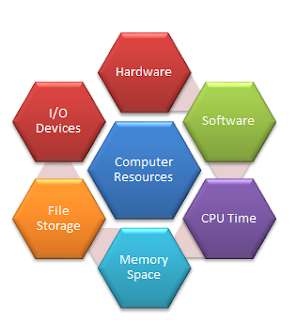User View:
The user view of the computer varies by the interface being used. Most computer users sit in front of a PC, consisting of a monitor, keyboard mouse and system unit. Such a system is designed for one user to monopolize its resources, to maximize the work that the user is performing. In this case, the operating system is designed mostly for ease of use, with some attention paid to performance and none paid to resource utilization.
Some users sit at a terminal connected to a mainframe or minicomputer.
Other users are accessing the same computer through other terminals. These users share resources and may exchange
information. The operating system is
designed to maximize resource utilization- to ensure that all available CPU
time, memory, and IO are used efficiently and that no individual user takes
more than his/her fair share.
Other users sit at workstations connected to networks of other
workstations and servers. These users have dedicated resources at their
disposal, but they also share resources such as networking and servers- file,
compute and print server. Therefore their operating system is designed to
compromise between individual usability and resource utilization.
Recently many varieties of handheld computers have come into
fashion. These devices are mostly stand alone, used singly by individual users.
Some are connected to networks, either directly by wire or through wireless
modems. Due to power and interface limitations they perform relativity few
remote operations. The operating systems are designed mostly for individual
usability but performance per amount of battery life is important as well.
Some computers have little or no user review. For example,
embedded computers in home devices and automobiles may have a numeric keypad
and may turn indicator lights on or off to show status, but mostly they and
their operating systems are designed to run without user intervention.
System View:
·
OS as a Resource Manager:
From the computer’s point of view, the operating system is the program that is most intimate with the hardware. We can view an operating system as a resource allocator. A computer system has a many resources - hardware and software that may be required to solve a problem: CPU time, memory, file storage, IO devices and so on. The operating system acts as a manager of these resources.
·
OS as a Control Program:
An operating system is
a control program. A control program manages execution of user programs to
prevent errors and improper use of the computer. It is especially concerned
with the operation and control of IO devices.
A more common definition is that the operating system is the
one program running at all times on the computer usually called the kernel,
with all else being application programs.
Fig: Various resources of a computer system

No comments:
Post a Comment